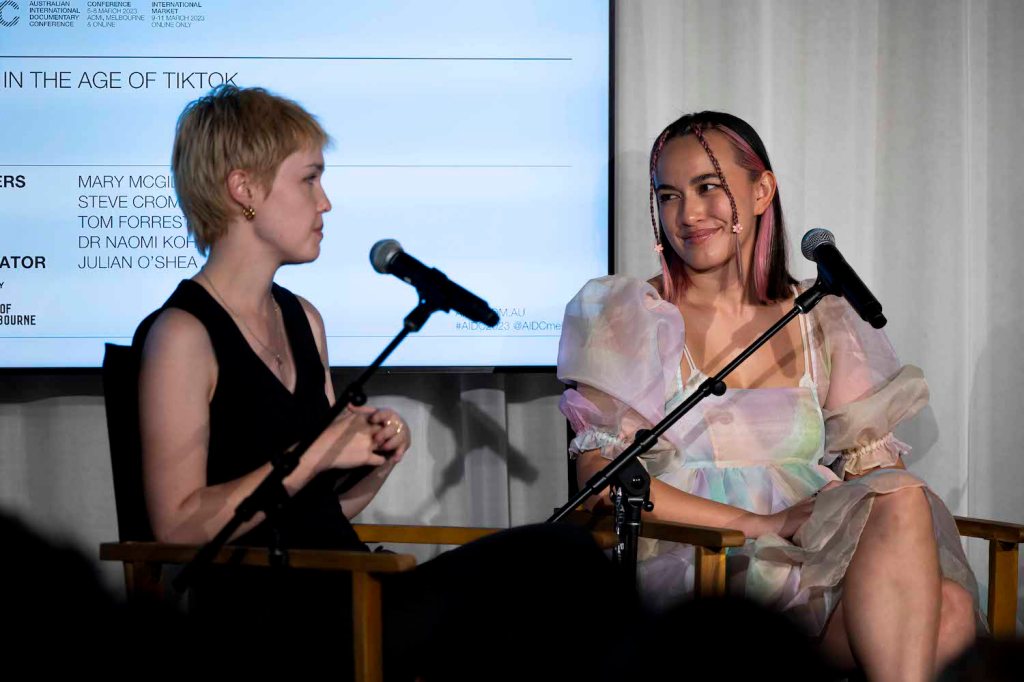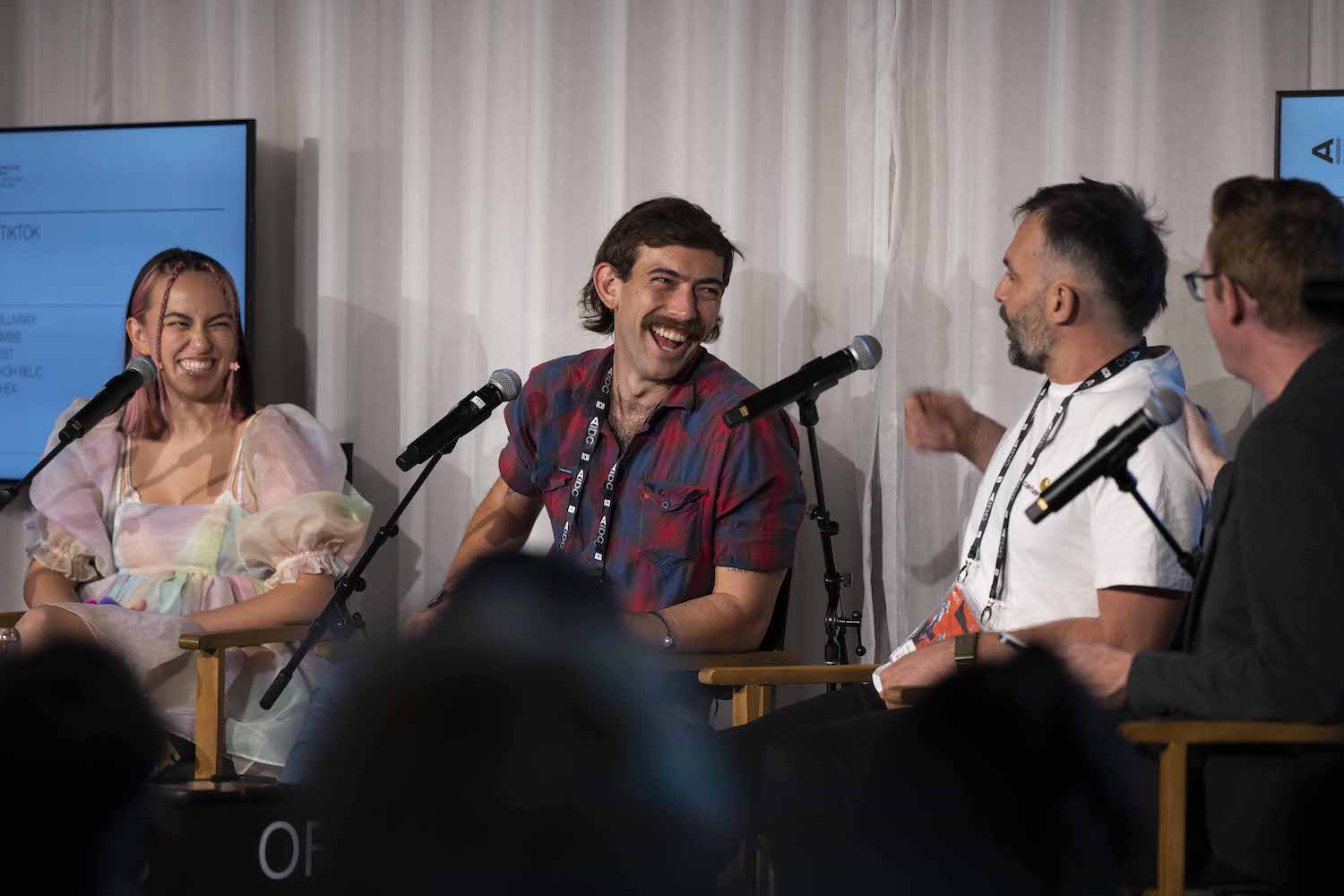For documentary and factual filmmakers who want their content to educate, inform and drive change, the scale of potential audience that social media affords has obvious appeal.
That said, social media is cut throat. If you can’t grab someone’s attention in seconds, chances are they’re scrolling on by.
So how do you make non-fiction content for social platforms that captures and holds attention? How do you condense big topics into 60 seconds? Oh, and is there a business model for this sort of content?
These were among the topics of conversation at the Australian International Documentary Conference (AIDC) on Sunday, on a panel that included art historian Mary McGillivray (@_theiconoclass), scientist Dr Naomi Koh Belic (@naomikohbelic), ABC Indigenous journalist Tom Forrest (@outbacktom) and Totem Global CEO/founder Steve Crombie, moderated by Julian O’Shea.

These are of some of their insights:
Pick your fighter.
TikTok, Instagram, Snapchat, Facebook or Youtube; each has a very different audience. Content that works on one platform may not work on the other. Work out who the audience you want to speak to is and what platform they are most likely on.
Crombie said TikTok skews around 13-17 years old, though the 20-35 demographic on the platform has increased. Facebook, on the other hand, skews much older at 30+.
“Just focus on one platform and do it well,” he advised delegates. “It’s easy to grow one plant very, very tall, but for the same energy, four plants are going to be pretty small.“
McGillivray posts the same art history content on both TikTok and Instagram, but said her audience on each platform is different, and the algorithm works differently too.
“The number one thing that I would say to anyone wanting to decide which platform to post to is to be on the platform and to be obsessed with it,” she said.
“You need to know how the audience behave, what they like, what works, what doesn’t work. I don’t think it’s the case of just making a vertical video and then putting it on YouTube Shorts, Reels, TikTok and seeing what happens because you’ll notice that it might do really well on Reels on Instagram and then tank on TikTok. Knowing the platform inside out is key.”
There’s an audience for everything.
O’Shea, who produces YouTube series Unknown Melbourne, argued that in terms of subject matter, the world is your oyster.
“There’s no such thing as too niche online. There’s no such thing as too weird online. Doesn’t matter what the topic is, there’ll be a group of people who want to see it, and they may not be people that are represented by mainstream broadcasters,” he said.
Crombie said to make sure your subject is one you’re creatively passionate about, because it takes time to build a community around your content.
“If you don’t love it, you definitely shouldn’t do it because you have to be very fully devoted to the task at hand, which is to consistently create content in order to build an audience, to make it something that’s economically viable,” he said.
Totem works with titles like Bondi Rescue and Black As. For producers with a back catalogue, Crombie noted that you can retroactively match existing content to fit a platform, editing it to a structure and style that works.
“In the case of something like Bondi Rescue, when we started with them, they got 15 million views a year on YouTube. Last year, they got over a billion views on YouTube.
“We looked at their back catalogue and worked out how to redesign the content for different audience demographics. You can restructure and reframe.”
In vertical video, Belic believes the opening hook is key. It’s a constraint, but it’s also a chance to be creative.
“People tune out after less than a second. Having that opening hook is really important. Anything that can tie it back to something that people care about… any silly way to get people actually paying attention.”
Keep trying.
If your content doesn’t work initially, don’t give up. Keep refining what you’re making; producing social media content is like traditional development in real time with audience feedback.
Crombie advised to use analytics to your advantage; they inform you what your audience likes and what it doesn’t.
“It gives you an opportunity to test, iterate, learn, refine the characteristics of content that they enjoy, whether it’s a character, a genre, a location, a time of day, and even to get the data on how old they are, where they are, what they like.”
Algorithms for each platform are different and shift constantly. To help get your head around it, Crombie suggests tools such as Tubular.
However, McGillivray said paying too much attention to algorithms can stifle creativity.
“Sometimes you make something that you do not expect to go well, and then it does even though you didn’t make it for the algorithm. I think that if you have passion and are not thinking too hard about it, that’s always going to be the content that shines.”
When one video can get 5 million views, and another just 5,000, Forrest said it can be hard to get your head out of the numbers. In those moments, it’s important to remember why you’re doing it.
“I learnt through making all these films over time, that the kick has never been out of a viral video. The kick is always in making the video.”
Forrest encouraged everyone with an idea just to try.
“It’s very easy as a creative person, whether you’re a musician, painter or a filmmaker, to put an endless amount of hurdles in front of yourself. One of the best things you can do is just go out there and do it. Maybe it’s even trying [an idea] in a shorter or smaller budget sense. But there’s nothing more real than just making something and putting it out there and finding out [if it works] first.”
Social media is just that: social.
McGillivray said “any woman online” knows that negative comments come with the territory. They tend to increase the more viral a video goes; when it goes beyond your bread-and-butter audience.
“There’s always going to be trolls and there’s always going to be harassment… Having a really strong support group around you to help you cope with that is super important.”
Belic, whose ABC Queer post about the health benefits of masturbation received backlash from some politicians and media outlets, echoes the sentiment.
“I can’t exist as a queer woman of colour on social media without bigots. That’s inevitable. So I have a really good support network. I talk a lot about risk reduction and putting plans in place with my therapist, and that makes it all manageable.”
However, Crombie noted that comments are important for building a community; that community will also then defend you from trolls.
“The old school way was just delete the bad comments. But these days it’s actually about engaging with them, if you can, and turning them around. You can build a community of other like minded people that help you keep that environment positive” he said.
“You’re there for them, and they’re there for you… It’s not just creating the content, a huge part of it is managing and building a community. If you don’t have a community, you’re not going to go anywhere.”
Social media is not just a stepping stone into traditional film and TV.
Once upon a time – that is, a little less than a decade ago – demonstrating an audience online was seen as an effective path to getting a broadcast commission.
It certainly still can be, but Crombie observed filmmakers are increasingly making content for social alone.
“A lot of people who create content for social no longer want to be on TV, because they make more money on social; it’s easier for them to iterate and they’re completely unencumbered,” Crombie says.
Forrest first appeared on the ABC as a subject in Princess Pictures’ series My Year 12 Life, with the broadcaster then giving him his own series, The Kununurra Kid. He continues to work for the ABC as a journalist, but makes his Outback Tom content alongside.
“One experience with the ABC, which I really enjoy, is the fact that I have access to resources like tools, equipment and support from producers… and through that we can uphold a very truthful, honest and well fact-checked piece of content. One thing I’ve had trouble with is getting certain projects off the ground. Maybe there’s too many chefs, or, as I say, heads in the trough. Something I really enjoy in doing my Outback Tom content myself is that I have full creative control. I can do whatever I want.”
Yes, you can make a living.
In terms of financing content, McGillivray has started working with ABC Arts within the last year, and has had partnerships with museums, galleries and cultural organisations.
Belic also works with the ABC, and with organisations such as Deadly Science which helps to source philanthropic, industry and grant funding. Her content also lends itself to education partners; she’s touring this year with the Sydney Symphony Orchestra’s children’s education program.
While Forrest works full time as a journalist and isn’t interested in brand partnerships, he has been made offers ranging from $800 to up to $4,200 for what would be an hour’s work. He’s also observed some TikTok creators are trying to make the jump to “long-form” on YouTube, as creators can take more share in ad revenue.
Totem’s business model is based on growing audiences on social media platforms and then monetising them, with Crombie noting there are many pathways.
“If you’ve got long-form, you can drive [audience] back to your TVOD channels, they can buy the long-form version. You can create merchandise. You can do a brand integration. You can create an NFT. You can do [subscriber] memberships on your channel.”
AIDC runs until March 8.


